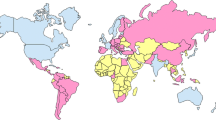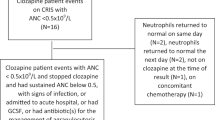Abstract
Purpose
Treatment with metamizole (dipyrone) has steadily increased in Germany over the last decade. The consequences of this increase for metamizole-induced agranulocytosis (MIA) are unclear. The present study addressed this topic using data from the Berlin Case–Control Surveillance Study.
Methods
Adult patients (≥18 years of age) with acute nonchemotherapy-induced agranulocytosis were identified by active surveillance in all 51 Berlin hospitals between 2000 and 2010. Cases related to metamizole were ascertained applying the drug causality criteria of the World Health Organization. The incidence rate of MIA was calculated and standardised by age and sex based on the German standard population in 2010.
Results
Twenty-six MIA cases out of 88 (30 %) patients with validated agranulocytosis were ascertained. The incidence of MIA was 0.96 (95 % confidence interval (CI) 0.95–0.97) cases per million per year. The median age of MIA cases was 50 years (quartile (Q)1 31 years; Q3 68 years) and 19 (73 %) of them were women. In 17 (65 %) cases, neutrophil granulocytes dropped below the value of 0.1 × 109 cells/L with three patients suffering from sepsis. Headache and postoperative pain were the most frequent indications for metamizole in outpatients (n = 16) and inpatients (n = 10), respectively. The median treatment duration was 6 days (Q1 4 days; Q3 19 days).
Conclusions
MIA persists as a severe condition in current pharmacotherapy. The continuous increase of metamizole applications should be critically assessed, especially in regard to indications in the outpatient setting and with respect to metamizole treatment duration.



Similar content being viewed by others
References
Benjamin JE, Bierman JB (1936) Agranulocytic leukopenia induced by a drug related to aminopyrine. JAMA 107:493–494
International Agranulocytosis and Aplastic Anemia Study (1986) Risks of agranulocytosis and aplastic anemia. A first report of their relation to drug use with special reference to analgesics. JAMA 256:1749–1757
Ibanez L, Vidal X, Ballarin E, Laporte JR (2005) Agranulocytosis associated with dipyrone (metamizol). Eur J Clin Pharmacol 60:821–829
Basak GW, Drozd-Sokolowska J, Wiktor-Jedrzejczak W (2010) Update on the incidence of metamizole sodium-induced blood dyscrasias in Poland. J Int Med Res 38:1374–1380
Van der Klauw MM, Goudsmit R, Halie MR, van’t Veer MB, Herings RM, Wilson JH, Stricker BH (1999) A population-based case-cohort study of drug-associated agranulocytosis. Arch Intern Med 159:369–374
Hedenmalm K, Spigset O (2002) Agranulocytosis and other blood dyscrasias associated with dipyrone (metamizole). Eur J Clin Pharmacol 58:265–274
Bhaumik S (2013) India’s health ministry bans pioglitazone, metamizole, and flupentixol-melitracen. BMJ 347:f4366
AbZ Pharma GmbH Ulm (2013) Metamizole-Summary of medicinal product characteristics. http://www.fachinfo.de. Accessed 16 Oct 2014
Kölzsch M, Wulff I, Ellert S, Fischer T, Kopke K, Kalinowski S, Drager D, Kreutz R (2012) Deficits in pain treatment in nursing homes in Germany: a cross-sectional study. Eur J Pain 16:439–446
Gazibara T, Nurkovic S, Kisic-Tepavcevic D, Kurtagic I, Kovacevic N, Gazibara T, Pekmezovic T (2013) Pharmacotherapy and over-the-counter drug use among elderly in Belgrade, Serbia. Geriatr Nurs 34:486–490
De Abajo FJ, Gil MJ, Garcia PP, Bryant V, Oliva B, Timoner J, Garcia-Rodriguez LA (2014) Risk of nonfatal acute myocardial infarction associated with non-steroidal antiinflammatory drugs, non-narcotic analgesics and other drugs used in osteoarthritis: a nested case–control study. Pharmacoepidemiol Drug Saf. doi:10.1002/pds.3617
Pogatzki-Zahn E, Chandrasena C, Schug SA (2014) Nonopioid analgesics for postoperative pain management. Curr Opin Anaesthesiol 27:513–519
Varas-Lorenzo C, Riera-Guardia N, Calingaert B, Castellsague J, Pariente A, Scotti L, Sturkenboom M, Perez-Gutthann S (2011) Stroke risk and NSAIDs: a systematic review of observational studies. Pharmacoepidemiol Drug Saf 20:1225–1236
Wehling M (2014) Non-steroidal anti-inflammatory drug use in chronic pain conditions with special emphasis on the elderly and patients with relevant comorbidities: management and mitigation of risks and adverse effects. Eur J Clin Pharmacol 70:1159–1172
Dahan A, Overdyk F, Smith T, Aarts L, Niesters M (2013) Pharmacovigilance: a review of opioid-induced respiratory depression in chronic pain patients. Pain Physician 16:E85–E94
McNicol E, Horowicz-Mehler N, Fisk RA, Bennett K, Gialeli-Goudas M, Chew PW, Lau J, Carr D (2003) Management of opioid side effects in cancer-related and chronic noncancer pain: a systematic review. J Pain 4:231–256
American Geriatric Society (2012) American Geriatrics Society updated beers criteria for potentially inappropriate medication use in older adults. J Am Geriatr Soc 60:616–631
Holt S, Schmiedl S, Thurmann PA (2010) Potentially inappropriate medications in the elderly: the PRISCUS list. Dtsch Arztebl Int 107:543–551
Garbe E, Andersohn F, Bronder E, Klimpel A, Thomae M, Schrezenmeier H, Hildebrandt M, Spath-Schwalbe E, Gruneisen A, Mayer B, Salama A, Kurtal H (2011) Drug induced immune haemolytic anaemia in the Berlin Case–Control Surveillance Study. Br J Haematol 154:644–653
Garbe E, Andersohn F, Bronder E, Salama A, Klimpel A, Thomae M, Schrezenmeier H, Hildebrandt M, Spath-Schwalbe E, Gruneisen A, Meyer O, Kurtal H (2012) Drug-induced immune thrombocytopaenia: results from the Berlin Case–Control Surveillance Study. Eur J Clin Pharmacol 68:821–832
Douros A, Bronder E, Andersohn F, Klimpel A, Thomae M, Ockenga J, Kreutz R, Garbe E (2013) Drug-induced acute pancreatitis: results from the hospital-based Berlin Case–Control Surveillance Study of 102 cases. Aliment Pharmacol Ther 38:825–834
Huber M, Andersohn F, Bronder E, Klimpel A, Thomae M, Konzen C, Meyer O, Salama A, Schrezenmeier H, Hildebrandt M, Spath-Schwalbe E, Gruneisen A, Kreutz R, Garbe E (2014) Drug-induced agranulocytosis in the Berlin Case–Control Surveillance Study. Eur J Clin Pharmacol 70:339–345
The Uppsala Monitoring Centre (2012) The use of the WHO-UMC system for standardised case causality assessment. WHO-UMC web. http://who-umc.org/Graphics/24734.pdf. Accessed 10 Jul 2014
Deutschland Regionalstatistik. Regionaldatenbank Deutschland. Düsseldorf 2010. http://www.regionalstatistik.de/genesis/online;jsessionid=9DE71A1700AF2182E35C5CD292700FB8?Sequenz=tabelleErgebnis&selectionname=173-21-4. Accessed 10 Jul 2014
WIdO Research Institute(‘Wissenschaftliches Institut der AOK’), Berlin, Germany (2014) Arzneimittel. http://www.wido.de. Accessed 16 Oct 2014
Ibanez L, Vidal X, Ballarin E, Laporte JR (2005) Population-based drug-induced agranulocytosis. Arch Intern Med 165:869–874
Garbe E (2007) Non-chemotherapy drug-induced agranulocytosis. Expert Opin Drug Saf 6:323–335
Bottiger LE, Westerholm B (1973) Drug-induced blood dyscrasias in Sweden. Br Med J 3:339–343
Backstrom M, Hagg S, Mjorndal T, Dahlqvist R (2002) Utilization pattern of metamizole in northern Sweden and risk estimates of agranulocytosis. Pharmacoepidemiol Drug Saf 11:239–245
Duarte Souza JF, Lajolo PP, Pinczowski H, del Giglio A (2007) Adjunct dipyrone in association with oral morphine for cancer-related pain: the sooner the better. Support Care Cancer 15:1319–1323
Lux EA, Stamer U, Meissner W, Wiebalck A (2011) Postoperative pain management after ambulatory surgery. A survey of anaesthesiologists. Schmerz 25:191–198
Curtis BR (2014) Drug-induced immune neutropenia/agranulocytosis. Immunohematology 30:95–101
Hargis JB, La Russa VF, Redmond J, Kessler SW, Wright DG (1989) Agranulocytosis associated with “Mexican aspirin” (dipyrone): evidence for an autoimmune mechanism affecting multipotential hematopoietic progenitors. Am J Hematol 31:213–215
Heimpel H (1988) Drug-induced agranulocytosis. Med Toxicol Adverse Drug Exp 3:449–462
Garcia S, Canionero M, Lopes G (2006) Dipyrone-induced granulocytopenia: a case for awareness. Pharmacotherapy 26:440–442
Isk M, Kaya Z, Belen FB, Aktas AT, Tezer H, Gursel T (2014) Life-threatening agranulocytosis, anemia, and plasmacytosis after dipyrone Use for fever in a child. J Pediatr Hematol Oncol 36(1):e46–e48
Drug Commission of the German Physicians (2011) (Arzneimittelkommission der Deutschen Ärzteschaft). “Aus der UAW-Datenbank”Agranulozytose nach Metamizol – sehr selten, aber häufiger als gedacht. Deutsches Ärzteblatt 108(33):A-1758 / B-1498 / C-1494
Institute for Drugs and Medical Devices in Germany (Bundesinstitut für Arzneimittel und Medizinprodukte), Rotthauwe J (2011) Metamizol – Indikationsstellung, Gegenanzeigen, Vorsichtsmaßnahmen und Warnhinweise beachten. Bull Arzneimittelsicherheit 3:9–11, available from: http://www.pei.de/SharedDocs/Downloads/vigilanz/bulletin-zur-arzneimittelsicherheit/2011/3-2011.pdf?__blob=publicationFile&v=1. Accessed 16 Oct 2014
Acknowledgments
Cases were collected within the study ‘Berlin Case–Control Surveillance (FAKOS) of Serious Blood Dyscrasias’, which was funded by a grant from the Federal Institute for Drugs and Medical Devices (Bonn, Germany). We wish to thank all members of the Haematological Advisory Board (Hubert Schrezenmeier, Martin Hildebrandt, Ernst Späth-Schwalbe, Andreas Grüneisen, Abdulgabar Salama) and all hospitals contributing cases and controls to this study. A list of the hospitals is given in the Appendix. We wish to thank the Wissenschaftliches Institut der AOK (WIdO) Research Institute (Berlin, Germany) for the provided data on metamizole dispensation rates.
Contributions of Authors statement
Study concept and design: Edeltraut Garbe and Elisabeth Bronder; acquisition of data: Edeltraut Garbe, Elisabeth Bronder, Frank Andersohn, Michael Thomae, Christine Konzen and Giselle Sarganas; analysis and interpretation of data: Edeltraut Garbe, Matthias Huber, Andreas Klimpel, Frank Andersohn, Elisabeth Bronder, Michael Thomae, Reinhold Kreutz, Christine Konzen and Giselle Sarganas; drafting the manuscript: Matthias Huber and Edeltraut Garbe; critical revision of the manuscript: all authors; study supervision: Edeltraut Garbe and Elisabeth Bronder. All authors have approved the final draft submitted.
Conflict of interest
The authors declare that they have no conflict of interest.
Author information
Authors and Affiliations
Corresponding author
Electronic supplementary material
Below is the link to the electronic supplementary material.
Supplemental Table 1
(DOCX 43 kb)
ESM 1
(DOCX 39 kb)
Rights and permissions
About this article
Cite this article
Huber, M., Andersohn, F., Sarganas, G. et al. Metamizole-induced agranulocytosis revisited: results from the prospective Berlin Case–Control Surveillance Study. Eur J Clin Pharmacol 71, 219–227 (2015). https://doi.org/10.1007/s00228-014-1777-8
Received:
Accepted:
Published:
Issue Date:
DOI: https://doi.org/10.1007/s00228-014-1777-8




